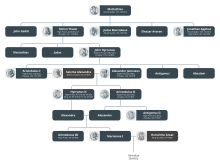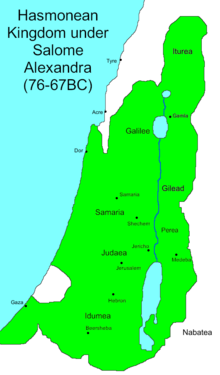| This article needs additional citations for verification. Please help improve this article by adding citations to reliable sources. Unsourced material may be challenged and removed. Find sources: "Salome Alexandra" – news · newspapers · books · scholar · JSTOR (September 2023) (Learn how and when to remove this message) |
| Salome Alexandra | |
|---|---|
 Salome Alexandra, from Guillaume Rouillé's Promptuarii Iconum Insigniorum Salome Alexandra, from Guillaume Rouillé's Promptuarii Iconum Insigniorum | |
| Queen of Judaea | |
| Reign | c. 76 – 67 BC |
| Predecessor | Alexander Jannaeus |
| Successor | Hyrcanus II |
| Queen consort of Judaea | |
| Tenure | c. 104–76 BC |
| Spouse | Aristobulus I (c. 104 – 103 BC) Alexander Jannaeus (c. 103 – 76 BC) |
| Issue | Hyrcanus II |
| Father | Shetah (disputed) |
| Religion | Judaism |
Salome Alexandra, or Shlomtzion (Ancient Greek: Σαλώμη Ἀλεξάνδρα; Hebrew: שְׁלוֹמְצִיּוֹן, Šəlōmṣīyyōn, "peace of Zion"; 141–67 BC), was a regnant queen of Judaea, one of only three women in Jewish historical tradition to rule over the country, the other two being Deborah and Athaliah. The wife of Aristobulus I, and afterward of Alexander Jannaeus, she was also the last ruler of Judaea to die as the sovereign of an independent kingdom. Her nine-year reign has been described as a "golden age" of Hasmonean history.
Name
Josephus does not use the Hebrew name of Shlomzion (Salome), referring only to her Greek name, "Alexandra" (Ἀλεξάνδρα). This is the only known Greek name among Hasmonean women. Salome's granddaughters also bore this name. Rabbinic literature, however, never uses the name Alexandra for her, instead referring to her with various Semitic names. The Dead Sea Scrolls have identified Alexandra as "Shlomzion" (שלמציון) in several texts, including 4Q331 and 4Q332.
Family

Salome Alexandra's personal genealogy is not given by Josephus, nor does it appear in any of the Books of the Maccabees. Rabbinical sources designate the rabbi Simeon ben Shetach as her brother, making her the daughter of Shetah as well. Salome Alexandra's oldest son by Alexander Jannaeus was Hyrcanus II who fought his younger brother Aristobulus II in 73 BC over the Jewish High Priesthood. Hyrcanus II was eventually successful after enlisting the help of the Nabataean king, Aretas III; bribing Roman officials, including Scaurus; and gaining the favour of Pompey, who defeated his brother and took him away to Rome.
Consort
According to the Jewish Encyclopedia, Salome Alexandra was instrumental in arranging the assassination of her brother-in-law, Antigonus, by convincing her husband that his brother was plotting against him. Upon the death of Aristobulus in 103 BC, Aristobulus' widow freed his half-brother, Alexander Jannaeus, who had been held in prison.
During the reign of Alexander, who (according to the historian Josephus) apparently married her shortly after his accession, Alexandra seemed to have wielded only slight political influence, as evidenced by the hostile attitude of the king to the Pharisees.
Josephus does not explicitly state Alexandra held any political authority before her reign. However, a passage about the Herodian dynasty in Antiquities, where Josephus describes Antipas, the grandfather of Herod the Great, gaining political power when "King Alexander and his wife (= Alexandra) made him general of all Idumaea", suggests that Alexandra had some sort of power in Judaea even before she inherited the kingdom. Jewisharchive.org has her as queen for 40 years and she was their 40 years of blessing. Shlomzion means peace to Zion/peace of Zion.
Political ability
The frequent visits to the palace of the chief of the Pharisaic party, Simeon ben Shetach, who was said to be the queen's brother, must have occurred in the early years of Alexander's reign, before Alexander had openly broken with the Pharisees. Alexandra does not seem to have been able to prevent the persecution of that sect by her husband.
According to archaeologist Kenneth Atkinson, "There are also some passages in the Talmud that say, during her husband's reign, that she protected Pharisees and hid Pharisees from his wrath." Nevertheless, the married life of the royal pair seems to have ended cordially; on his deathbed Alexander entrusted the government, not to his sons, but to his wife, with the advice to make peace with the Pharisees.
Salome Alexandra's next concern was to open negotiations with the leaders of the Pharisees, whose places of concealment she knew. Having been given assurances as to her future policy, they declared themselves ready to give Alexander's remains the obsequies due to a monarch. By this step she avoided any public affront to the dead king, which, owing to the embitterment of the people, would certainly have found expression at the interment. This might have been attended with dangerous results for the Hasmonean dynasty.
Sole reign
| This section does not cite any sources. Please help improve this section by adding citations to reliable sources. Unsourced material may be challenged and removed. (September 2023) (Learn how and when to remove this message) |
Salome Alexandra received the reins of government (76 or 75 BC) at Jannaeus' camp before Ragaba, and concealed the king's death until the fortress had fallen, in order that the rigour of the siege might be maintained. She succeeded for a time in quietening the vexatious internal dissensions of the kingdom that existed at the time of Alexander's death; and she did this peacefully and without detriment to the political relations of the Jewish state to the outside world. Alexandra managed to secure assent to a Hasmonean monarchy from the Pharisees, who had suffered under Alexander.
Re-establishment of the Sanhedrin
The Pharisees now became not only a tolerated section of the community, but actually the ruling class. Salome Alexandra installed as high priest her eldest son, Hyrcanus II, a man who was wholly supportive of the Pharisees and the Sanhedrin was reorganized according to their wishes and became a supreme court for the administration of justice and religious matters, the guidance of which was placed in the hands of the Pharisees.
Internal and external policy

The Sadducees were moved to petition the queen for protection against the ruling party. Salome Alexandra, who desired to avoid all party conflict, removed the Sadducees from Jerusalem, assigning certain fortified towns for their residence.
Salome Alexandra increased the size of the army and carefully provisioned the numerous fortified places so that neighbouring monarchs were duly impressed by the number of protected towns and castles which bordered the Judean frontier. As well, she did not abstain from actual warfare; she sent her son Aristobulus with an army to besiege Damascus, then beleaguered by Ptolemy Mennaeus. The expedition reportedly achieved little.
The last days of Salome Alexandra's reign were tumultuous. Her son, Aristobulus, endeavoured to seize the government, and succeeded her after her death.
Prosperity
Rabbinical sources refer in glowing terms to the prosperity which Judea enjoyed under Salome Alexandra. The Talmud (Ta'anit, 23a; Sifra, ḤuḲḲat, i. 110) relates that during her rule, as a reward for her piety, rain fell only on Sabbath (Friday) nights; so that the working class suffered no loss of pay through the rain falling during their work-time. The fertility of the soil was so great that the grains of wheat grew as large as kidney beans; oats as large as olives; and lentils as large as gold denarii. The sages collected specimens of these grains and preserved them to show future generations the rewards of obedience to the Law, and what piety could achieve.
Legacy
| This section does not cite any sources. Please help improve this section by adding citations to reliable sources. Unsourced material may be challenged and removed. (September 2023) (Learn how and when to remove this message) |
"Shlomtzion" (Hebrew: שלומציון) is sometimes used as a female first name in contemporary Israel. Among others, the well-known Israeli writer Amos Kenan gave the name to his daughter.
During the British Mandate of Palestine, a major street in Jerusalem was called Princess Mary Street, after the only daughter of King George V and Queen Mary. After the creation of Israel, the street was renamed "Queen Shlomzion Street," to commemorate the Jewish queen. Such street names exist also in Tel Aviv and Ramat Gan.
In the 1977 Knesset elections Ariel Sharon accepted the advice of Kenan to name his new political party "Shlomtzion" (it later merged with the Likud).
Israeli zoologists carefully observing the leopards of the Judean Desert bestowed the name "Shlomtzion" on a female leopard whose life, mating, and offspring were the subject of intensive, years-long study. In 1996, her body was found in Tze'elim Stream, having died of old age.
In medieval sources
According to some versions of the Toledoth Yeshu, a medieval alternative-Christian life of Jesus, Salome is connected with Jesus of Nazareth, placing the death of Jesus 150 years earlier.
See also
References
- Atkinson, Kenneth (2012). Queen Salome: Jerusalem's Warrior Monarch of the First Century B.C. US: McFarland. p. 1. ISBN 978-0-7864-7002-0.
- That Alexandra, the widow of Aristobulus I, was identical with the one who married his brother Alexander Jannaeus is nowhere explicitly stated by Josephus, who, it is generally inferred, took it for granted that the latter performed the levirate marriage prescribed by the law for the widow of a childless brother deceased.
- ^ Kenneth (2016), 138
- Atkinson, Kenneth (2016). A History of the Hasmonean State: Josephus and Beyond. T & T Clark Jewish and Christian texts series. London; New York: Bloomsbury T&T Clark, an imprint of Bloomsbury Publishing Plc. pp. 133–134. ISBN 978-0-567-66902-5. OCLC 949219870.
- Catherine Hezser, ed. (2003). Rabbinic Law in Its Roman and Near Eastern Context. Mohr Siebeck. p. 207. ISBN 978-3-16-148071-3. OCLC 1088784294.
- Figure based upon Josephus (Antiquities 14.1.2), where, in the original Greek, is written: "Hyrcanus began his high priesthood on the third year of the hundred and seventy seventh Olympiad..., when presently Aristobulus began to make war against him." The 177th Olympiad corresponded with the 238th year of the Seleucid era, or what was then 73 BCE.
- See Josephus, Jewish War (1.107–55)
- "Aristobulus I", Jewish Encyclopedia
- Josephus' statement (Jewish Antiquities xv. 6, § 3), that Hyrcanus II, Jannaeus' eldest son, was eighty years old when he was put to death by Herod, in 31 BC, is probably erroneous, for that would set the year of his birth as 111 BCE, and Jannaeus himself was born in 125 BC, so that he could have been but fourteen when Hyrcanus was born to him. It is difficult to understand how a thirteen-year-old boy married a widow of thirty. The statement, made by Josephus (Jewish Antiquities xiii. 11, §§ 1, 2), that during the reign of Aristobulus, Aristobulus' wife, presumably Salome Alexandra, brought about the death of the young prince Antigonus I, because she saw in him a rival of her husband, lacks additional confirmation.
- Silver, Carly. "The Peace of Zion", Iron Ladies of the Ancient World, the Archaeological Institute of America (2010)
- Josephus, Flavius. "5". Antiquities. Vol. 15. pp. xiii.
- "#kidneybeans". Salome Alexandra, Queen of Judaea public profile. geni. 2003. Retrieved 11 April 2016.
- 1940 photo of Princess Mary Street with Rex Cinema in background, West Jerusalem on the Alamy website
- קוריאל, אילנה (4 January 2022). "האיש שתיעד את הנמרים האחרונים בעין גדי". Ynet (in Hebrew). Retrieved 27 June 2024.
- אלדד, קרני (2 December 2019). "בלי להותיר עקבות: האם נמרים עדיין חיים בארץ?". www.makorrishon.co.il. Retrieved 27 June 2024.
- Goldstein (1950). Jesus in the Jewish Tradition. New York: Macmillan. pp. 148–154. OCLC 1166662.
Sources
- Josephus, Antiquities xiii. 11, § 12; 15, § 16
- idem, B. J. i. 5
- Heinrich Ewald, History of Israel, v. 392–94
- Heinrich Grätz, Geschichte der Juden, 2d ed., iii. 106, 117–29
- Ferdinand Hitzig, Geschichte des Volkes Israel von Anbeginn bis zur Eroberung, ii. 488–90
- Emil Schürer, Geschichte des jüdischen Volkes im Zeitalter Jesu Christi i. 220, 229–33
- Joseph Derenbourg, Essai sur l'Histoire et la Géographie de Palestine, pp. 102–11
- Julius Wellhausen, I. J. G. Geschichte Israels pp. 276, 280–85
- F. W. Madden, Coins of the Jews, pp. 91, 92
- Atkinson, Kenneth (2016), A History of the Hasmonean State: Josephus and Beyond, Bloomsbury T&T Clark
- Hugo Willrich, Judaica: Forschungen zur Hellenisch-Jüdischen Geschichte und Litteratur, 1900, pp. 74, 96
External links
- Henry Gardiner Adams, ed. (1857). "Alexandra". A Cyclopaedia of Female Biography: 29. Wikidata Q115585343.
- Queen Salome Alexandra Entry in Chabad.org Gallery of Our Great
- The Salome No One Knows Archived 18 January 2009 at the Wayback Machine Biblical Archaeology Review July/August Issue
- The Jewish Queen Gates of Nineveh.
- Genealogy of the House of David- Salome Alexandra
![]() This article incorporates text from a publication now in the public domain: Louis Ginzberg (1901–1906). "Alexandra". In Singer, Isidore; et al. (eds.). The Jewish Encyclopedia. New York: Funk & Wagnalls.
This article incorporates text from a publication now in the public domain: Louis Ginzberg (1901–1906). "Alexandra". In Singer, Isidore; et al. (eds.). The Jewish Encyclopedia. New York: Funk & Wagnalls.
| Salome Alexandra Hasmonean Dynasty | ||
| Preceded byAlexander Jannaeus | Queen of Judaea 76 BCE – 67 BCE |
Succeeded byHyrcanus II |
| Rulers of Israel and Judah | |
|---|---|
| Israel (united monarchy) | |
| Israel (northern kingdom) | |
| Judah (southern kingdom) | |
| Judea (Hasmonean dynasty) | |
| See also | |